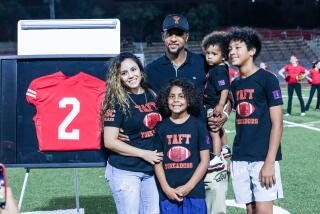Beautiful gestures at Bonita for, and from, Glenn Davis
- Share via
On a warm and clear night, at a suburban high school in the San Gabriel Valley, a legend named Glenn Davis was resurrected for a couple of hours Friday.
He has been dead for 2 1/2 years, but those who remember where he came from, Bonita High in La Verne, still remember to remember. What they did, in essence, was to complete a field of dreams in the name of a football player who was once the dream of their field.
He was 80 when he died on March 9, 2005, so his contemporaries are dwindling. Those who remain would certainly agree that the addition of a $1.2-million artificial turf field to Glenn Davis Stadium is yet another deserved tribute.
The enrollment at Bonita High is 1,890, and Principal Bob Ketterling was honest when asked how much students know about the man whose name is on their football stadium.
“Not so much,” he said.
It was the early 1940s when Davis was Mr. Everything in sports at Bonita. The 210 Freeway wasn’t even a concept, and the foothills that bordered La Verne and neighboring Claremont were never blotted from vision by smog. When Davis and his twin brother, Ralph, left for West Point, the surrounding communities knew how good an athlete he was, and the entire country was soon to find out.
He became part of the most famous collegiate backfield of all time, Doc Blanchard and Glenn Davis, Mr. Inside and Mr. Outside. They were consensus All-Americans for Army three straight years, 1944-45-46, the only time one backfield has achieved that. Blanchard was the battering ram, up the middle, setting it up for the end-around sprints of Davis, at that point one of the faster ballcarriers the college game had seen.
Blanchard, still alive at 82, won the Heisman Trophy in 1945. Davis won it the next year.
Stories of Davis’ athletic feats are well worn, and still amazing.
In a 1988 Sports Illustrated essay titled “Mr. Inside & Mr. Outside,” Ron Fimrite described how the cadets were put through a sports aptitude exercise that included such elements as a vertical jump, a 300-yard run, push-ups, a rope climb, a softball throw and several other tests.
“A perfect score was 1,000 points,” Fimrite wrote. “Before Davis, the record score was 901 1/2 and the average for all cadets was not quite 550. Davis scored an unheard-of 962 1/2 .”
Davis earned 10 letters at Army, four in football, three in baseball, two in track and one in basketball. Once, in the spring of 1947, after playing center field in a nine-inning baseball game against Navy, he was rushed to the outdoor track where the Army-Navy meet was going on. He hadn’t practiced with the track team and had to borrow a pair of spikes. No problem. He won the 100-yard dash in 9.7 seconds and set an Army record in the 220 at 20.9.
Davis served his time in the military, returned to Los Angeles for a short stint in pro football -- he played in one Pro Bowl -- and actually suffered the most serious injury of his athletic career when he was making a movie and hurt his knee. For more than 30 years, until his retirement in 1987, he served as director of special events for the Los Angeles Times.
He retired to a home in the desert, where a fellow worker ran into him in La Quinta in the early 1990s and asked how he kept himself busy. Davis, always a man of few words, said, “Well, I get up every morning, have breakfast, go out and play 18 holes with the same three guys, come home and my wife fixes me lunch. Then I take a nap, get up and take my wife out to dinner. The next day, I get up and do it again.”
It was maybe 10 years ago that Davis decided to give his Heisman Trophy to Bonita High. Dan Harden, a former football coach, was athletic director at the school then and recalled that day fondly Friday night.
“He had called to say he was going to give us the Heisman,” Harden said, “but he wouldn’t say exactly when he was coming. He was very clear. Do not call the newspapers or TV stations.
“I just happened to be walking outside the day he brought it. I saw a little old man and a little old woman walking along. I thought they were lost. Then I saw it. He was walking with his wife and just carrying it along, under his arm.
“We got him inside and he made sure we didn’t have a big ceremony or anything. So we went to the principal’s office and he gave it to us. And then, the most interesting thing happened. We were passing the school trophy case and he stopped and pointed to a baseball on a little stand. There were no markings on the ball. A group of community businessmen had given it to him for his baseball achievements. He knew exactly what it was.
“He asked if he could have it.”
Quite a trade. A 60-year-old, unmarked baseball for a Heisman.
And quite a legacy for the students of Bonita and the city of La Verne, who have made sure to remember somebody they should.
--
Bill Dwyre can be reached at bill.dwyre@latimes.com. To read previous columns by Dwyre, go to latimes.com/dwyre.
More to Read
Get our high school sports newsletter
Prep Rally is devoted to the SoCal high school sports experience, bringing you scores, stories and a behind-the-scenes look at what makes prep sports so popular.
You may occasionally receive promotional content from the Los Angeles Times.







